 Image 1 of 2
Image 1 of 2

 Image 2 of 2
Image 2 of 2



Field Guide : Bald Eagle
Unlimited edition. 18 x 24 inch, museum-quality poster on matte paper.
Growing up on the Eastern Shore of Virginia, I rarely saw bald eagles. I mean, sure, I often “saw” the bird in field guides, photographs, and on PBS nature documentaries, but “real life” sightings were exceptional. Today, my parents see bald eagles often on the Shore. Were I living on the verdant coast of Alaska or British Columbia, I’d see so many eagles that I might view them with the same ennui or even disgust many people have for gull species. What happened? Why the tremendous growth of the bald eagle population?
Recovery is the best word for it (although some folks might argue that it’s more of an overcorrection). In the late 1800s, ornithologists estimated that there were ~100,000 bald eagles in the United States. That number would soon plummet, though, due to sanctioned killing of the birds, habitat encroachment, and, most infamously, insecticide exposure. By the early 1960s, the bald eagle population estimate for the U.S. was ~1,000 birds, a 100-fold decrease. Fortunately, due to the 1940 Bald and Golden Eagle Protection Act and the banning of the once-ubiquitous insecticide, DDT, in 1972, as well as a robust conservation and habitat restoration effort, bald eagle numbers have turned around. The population in the Chesapeake Bay region, where I grew up, went from ~120 birds in the 1970s to ~4,000 today. The total U.S. population is now estimated to be 330,000–350,000 birds, over three times the population of the late 1800s! Their successful recovery and increasing numbers, though, shouldn’t mean we take this impressive bird of prey for granted.
I find this color column simple, yet especially pleasing; it shows the white of the celebrated “bald” head, as well as bands of chocolate umber, mocha, light taupe, khaki, amber, and gold. 🦅
Note: These archival poster prints feature rich, appealing colors. I encourage customers to take care in handling them until they are framed/protected for display; the darker colors on the matte paper can be scratched. They ship rolled, so customers need to flatten them before framing (or have their framer do so).
Charitable Sales Model: Whenever one of these poster prints is purchased, a charitable contribution equal to 10% of the print’s cost (or $3.60) is made to a nonprofit working to tackle environmental or social challenges. Read more about my charitable sales model here.
Unlimited edition. 18 x 24 inch, museum-quality poster on matte paper.
Growing up on the Eastern Shore of Virginia, I rarely saw bald eagles. I mean, sure, I often “saw” the bird in field guides, photographs, and on PBS nature documentaries, but “real life” sightings were exceptional. Today, my parents see bald eagles often on the Shore. Were I living on the verdant coast of Alaska or British Columbia, I’d see so many eagles that I might view them with the same ennui or even disgust many people have for gull species. What happened? Why the tremendous growth of the bald eagle population?
Recovery is the best word for it (although some folks might argue that it’s more of an overcorrection). In the late 1800s, ornithologists estimated that there were ~100,000 bald eagles in the United States. That number would soon plummet, though, due to sanctioned killing of the birds, habitat encroachment, and, most infamously, insecticide exposure. By the early 1960s, the bald eagle population estimate for the U.S. was ~1,000 birds, a 100-fold decrease. Fortunately, due to the 1940 Bald and Golden Eagle Protection Act and the banning of the once-ubiquitous insecticide, DDT, in 1972, as well as a robust conservation and habitat restoration effort, bald eagle numbers have turned around. The population in the Chesapeake Bay region, where I grew up, went from ~120 birds in the 1970s to ~4,000 today. The total U.S. population is now estimated to be 330,000–350,000 birds, over three times the population of the late 1800s! Their successful recovery and increasing numbers, though, shouldn’t mean we take this impressive bird of prey for granted.
I find this color column simple, yet especially pleasing; it shows the white of the celebrated “bald” head, as well as bands of chocolate umber, mocha, light taupe, khaki, amber, and gold. 🦅
Note: These archival poster prints feature rich, appealing colors. I encourage customers to take care in handling them until they are framed/protected for display; the darker colors on the matte paper can be scratched. They ship rolled, so customers need to flatten them before framing (or have their framer do so).
Charitable Sales Model: Whenever one of these poster prints is purchased, a charitable contribution equal to 10% of the print’s cost (or $3.60) is made to a nonprofit working to tackle environmental or social challenges. Read more about my charitable sales model here.